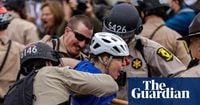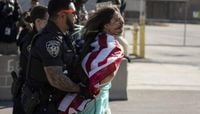The usually quiet streets of Broadview, Illinois, became the latest flashpoint in the national debate over immigration enforcement on October 17, 2025, as protesters and police clashed outside the U.S. Immigration and Customs Enforcement (ICE) processing facility. The demonstration, which began ahead of a 9 a.m. curfew, ended with at least eleven arrests and renewed scrutiny of federal and local authorities’ tactics.
This was the first major gathering since a federal judge ordered the removal of a metal fence that had encircled the facility on Beach Street. The fence, originally erected last month to keep demonstrators at bay, was dismantled late Tuesday night. Protesters saw its removal as a positive step, but their demands for greater transparency and fairer treatment by ICE remained front and center. As one protester, Dominic, put it to ABC7 Chicago, “The concrete barriers—these are public streets of Broadview. I feel like we have a right to be on them as well, so these need to come down next.”
The demonstration was far from the first at this west suburban ICE site, which has seen frequent protests against President Donald Trump’s aggressive deportation campaign in recent weeks. According to the Chicago Sun-Times, federal agents have responded to previous demonstrations with force, firing projectiles and chemical irritants—measures that a federal judge is now working to restrict. Friday’s protest was different in one respect: with the fence gone and a new executive order from Broadview Mayor Katrina Thompson, demonstrators were confined to two “free speech zones” totaling about 4,000 square feet. The mayor said this move was designed to limit disruptions and protect neighbors, but many protesters saw it as an attempt to stifle dissent.
“I think [the protest zones are] made to crowd people together and make it really easy for crowd control, restricting the times that we can be here and not letting us into public streets,” Cassidy, a regular protester, told the Chicago Sun-Times. “It seems like it’s all to keep limiting our actions until we can’t show up anymore.”
Illinois State Police, the Cook County Sheriff’s Office, and Broadview Police Department handled crowd control, with federal immigration officers mostly absent from view. The unified command of local and state agencies defended the restrictions, stating, “Blocking the street and occupying areas outside of the designated zones presents a serious public safety hazard, hampers residents’ ability to navigate their own Village, negatively impacts local businesses, makes it difficult for third parties (such as lawyers) to enter the facility to support detained individuals, and creates a dangerous situation where fast-moving vehicles are encountering people.”
Despite these justifications, the morning’s events were tense. Protesters arrived before the curfew, and by midday, eleven people—including a faith leader—had been arrested for leaving the designated zones and disobeying police orders. According to FOX 32, one individual faced charges of obstructing or resisting police, and at least eight had charges pending. Chants of “Who do you protect?” echoed as some protesters blocked a street outside the facility, refusing repeated requests to move. Kat Abughazaleh, a protester and congressional candidate, expressed her outrage: “A free speech zone implies that everywhere else is not a free speech zone.” She reported being struck in the face with a baton and witnessing another woman being shoved to the ground by officers.
Heidi Rodriguez, a 79-year-old protest regular, described being knocked down by police earlier in October. “They jumped out of cars with sticks. That’s what I’m against. They’re the ones that are causing the problems, because we didn’t have sticks, we didn’t have guns. They’re the ones that are rioting against us,” she told the Chicago Sun-Times. Rodriguez said she continues to protest because ICE’s actions have instilled fear in her community. “I have friends that won’t come out of their house because they’re afraid to go outside, and rightly so.”
The protests and the response from authorities have not gone unnoticed by the courts. On Thursday, U.S. District Judge Sara Ellis expressed alarm after viewing TV images of street confrontations involving tear gas and other aggressive tactics. She ordered that all federal immigration officers participating in “Operation Midway Blitz”—the federal crackdown that has resulted in more than 1,000 arrests in the Chicago area—must wear body cameras and keep them on during operations. “I am adding that all agents who are operating in Operation Midway Blitz are to wear body-worn cameras, and they are to be on,” Ellis said, as reported by FOX 32. She also summoned a senior ICE official to court to explain why tear gas had been used without warning, stating she was “a little startled” by what she had seen.
Judge Ellis’s concerns echoed those of many demonstrators. Protester Cynthia Harris told ABC7 Chicago, “Just the lack of due process. No due process whatsoever. Other presidents deported people, but it was an organized process.” Others, like Mary Pat, noted some progress: “I think we’re getting closer. I think at least the National Guard was pulled back. They’re allowing us to have our First Amendment to protest out here and say what we want to say.” Indeed, a federal appeals panel had just blocked the Trump administration’s attempt to deploy National Guard troops in Chicago, with Governor JB Pritzker calling the move “unlawful and unconstitutional.” Texas National Guard troops, seen outside the Broadview facility the previous week, had not returned as of Friday.
While the protests have focused on the treatment of immigrants and the conduct of federal agents, the Department of Homeland Security has defended its actions. According to FOX 32, DHS officials stated that those detained at Broadview include people convicted of serious crimes such as assault with a deadly weapon, felony robbery, and drug possession. The agency maintains that “Operation Midway Blitz” targets undocumented immigrants with criminal records, a point that has been hotly contested by advocates and some lawmakers.
U.S. Senator Dick Durbin weighed in on the controversy, criticizing federal agents for targeting Hispanic families and questioning the administration’s justification for the crackdown. “Is this America? Is this what we signed up for as Americans? To have this kind of fear?” Durbin asked, adding, “The president says this is about rapists and terrorists and criminals, and the criminally insane and sexual predators. It’s not. The people who are being detained and snatched off the street are not people who are guilty of those crimes, or even charged with those crimes.”
Immigrant advocates have also sounded the alarm about a spike in arrests of women and the resulting family separations. Eréndira Rendón, vice president of immigrant justice for the Resurrection Project, reported that at least eight women were taken into custody by ICE agents between October 5 and 11, double the number from the previous week. “That means more mothers are being separated from their children,” she told the Chicago Sun-Times. In some videos of the arrests, mothers can be heard pleading, “My children are home alone.”
For many in Broadview and across Chicago, the events of October 17, 2025, have become a symbol of the broader national struggle over immigration, civil rights, and the limits of government power. As large crowds were expected for a “No Kings Day” protest in downtown Chicago the following day, the city braced for further demonstrations, with both sides vowing to continue their fight—whether for security, transparency, or justice.

